St John’s churchyard, Eastover, was consecrated for burials in 1846. Some thirty years later, on 22 March 1875, a parish vestry meeting was convened to discuss the shortage of burial space remaining in the churchyard. It was decided at this meeting that a new cemetery would be needed for the parish, and a burial board of nine individuals would be established for Eastover.[1] In the following year we learn that the board included R.C. Else, C. Major, S. Perrett, H. Maidment, W. Hodge, W. Hickman, F. Clothier, E. Durston, and Hugh R. Poole was the clerk. Edwin Down was possibly also among their number, as he was surveyor and architect for the works. Rev J.W. Collins was the initial chairman, although he was later replaced by his successor, Rev Frederick P.S. Seale.[2] This new burial board appears to have formed itself with the broad intention of forming a mixed-denomination cemetery for the east side of the town, not just an extension or annex to St John’s Anglican-only churchyard.
In late September 1875, a Town Council meeting discussed the formation of this new burial board, apparently unhappy that the provision of a new cemetery was occurring without the consultation of the entire town. The primary concern though, was that they objected to the proposed site as unsanitary, both in its poor drainage and being too close to the town.[3] It is not clear where this initial land was. A government inspector was bought in to mediate, who recommended that St John’s burial board should help extend the Wembdon Road Cemetery, or participate in the establishment of a new cemetery for the entire town. Instead the burial board rejected these suggestions, and decided to continue on their own independent course and explore other sites.[4]
By May 1876 not only had a new site, ‘a rough and hilly field’ with ‘great cattle pits in the centre’ been found, it had been purchased from F.D. Clothier (one of the board), and the first phase of drainage was underway. A Mr Escott had laid a trunk from the land to the river by that August.[5]
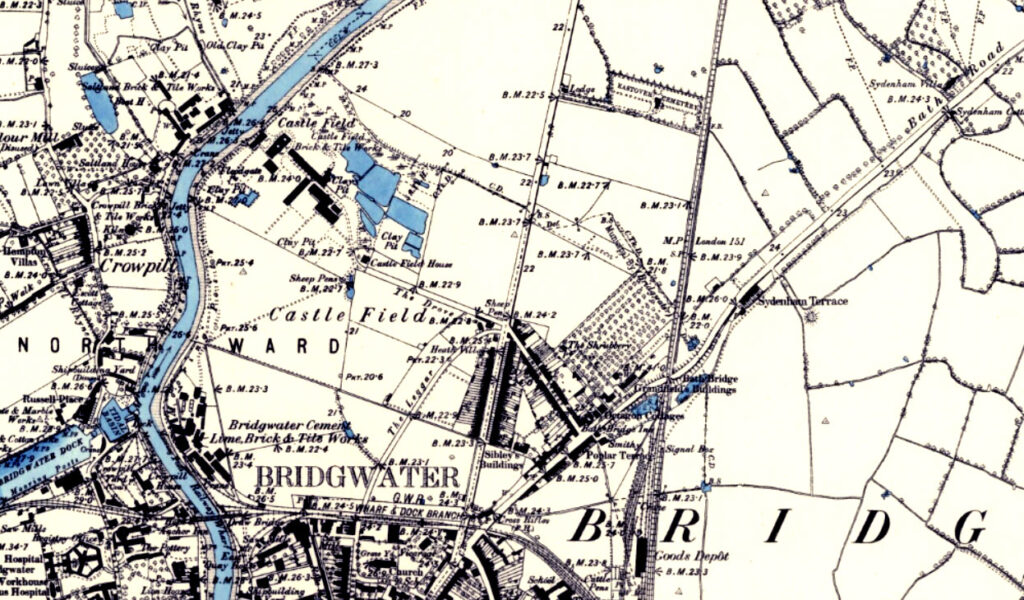
On 3 October 1876 the Burial Board advertised in local papers for contractors to undertake a second phase of drainage work.[6] In January 1876 a Mr Garstang was contracted to supply fencing for the cemetery’s northern side, to be four feet, six inches high, along with iron front gates, which he had done by November. The fence, a mixture of timber stakes and ironwork, was then erected by the ‘Signal Construction Company’. By December over 200 trees, unhelpfully described as ‘of all kinds’ had been purchased. The first major phase of ground levelling was being carried out by two men, over twenty one and a quarter days. A ditch within the site was filled with rubbish, while turf was taken away.[7]
In December 1876 the Board discussed the practicalities of raising the money for the cemetery from the parish rates, to pay back the loan they had taken. They appointed a caretaker to look after the site, deter vandalism and generally continue work improving the groundworks. They also started looking into how to apportion the land for different denominations. This made clear that the new cemetery was not like the old Wembdon Road, which was in theory two cemeteries divided between Church of England and Dissenter with two separate administrations and groundsmen; here one committee would manage the whole site. At this meeting Edwin Down bought his plans for the layout of the new cemetery. The board decided to move the chapels to the centre of the site, and wanted the entrance path to be a uniform width to the chapel, but otherwise approved.[8] The revised plan can be seen on the 1888 OS map for the area, shown below.
Edwin Down presented plans for the chapels in January 1877, although the board requested he revise them so both chapels would be under one roof, in order to save money.[9]
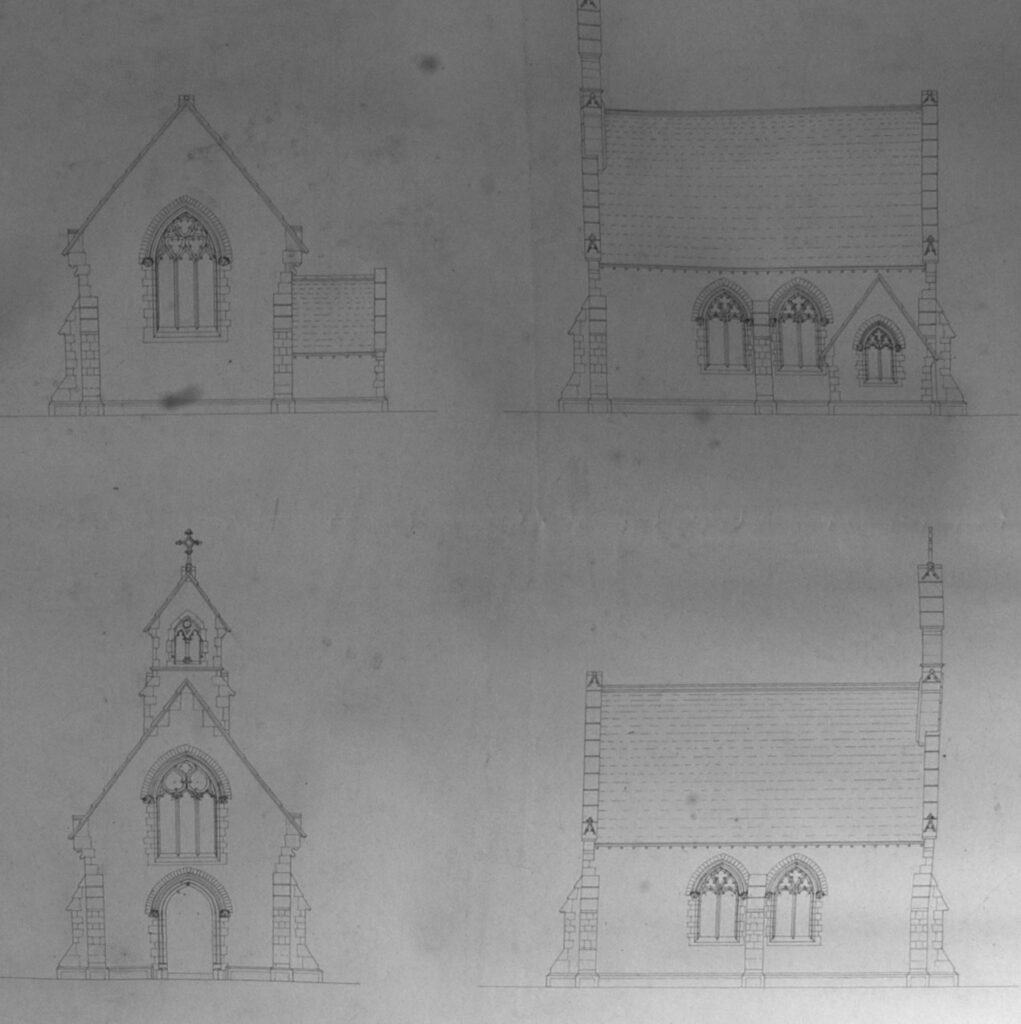
Revised plans for the chapel were presented in March 1877.[10]
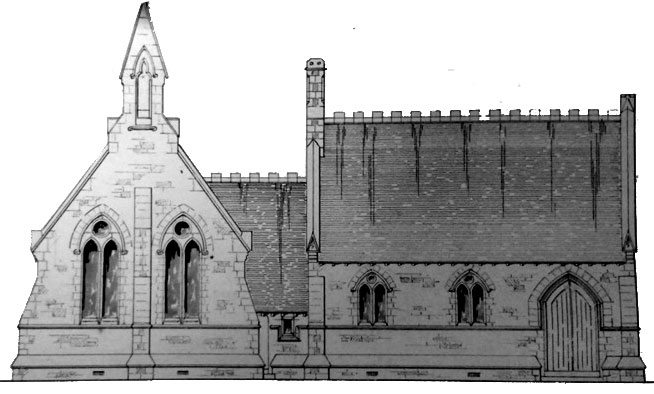
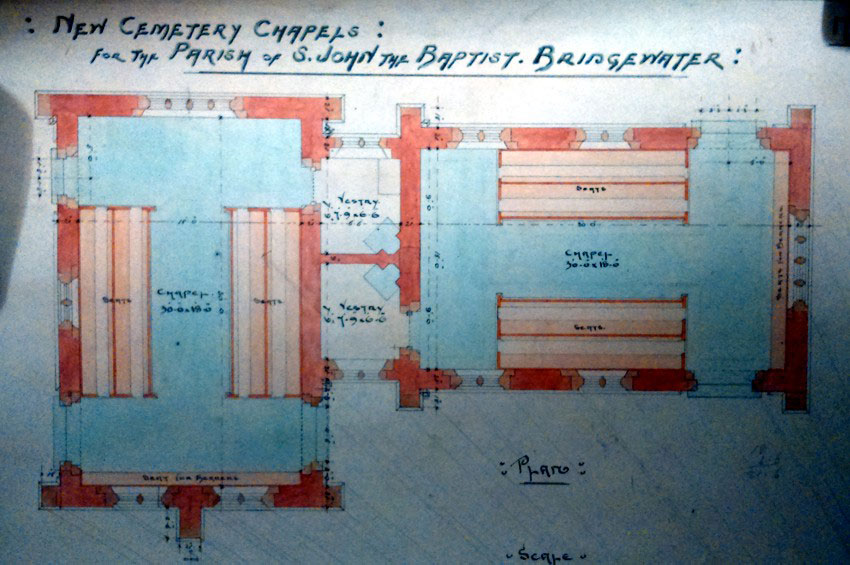
In April 1877 it was decided that the available burial space should be divided equally between Anglicans and Dissenters, divided by a path running east west. One sixth of the ground set aside for the non-conformists, would be given to the Roman Catholic congregation.[12]

It was also decided to build a cottage for the groundskeeper by the front entrance, for which more land would need to be purchased.[13] In May 1877 advertisements were placed in the local press for builders to tender for the construction of the lodge.[14] A Mr Ketch, a local builder, was awarded the contract and Bradfield & Sons, stonemasons (who also specialised in cemetery memorials) were employed to hew the stones.[15]
In July 1879 a table of fees for the cemetery were devised, in three major bands, section 1 being the cheapest burials (including ‘parish’ burials for paupers). A subsection of this included fees for the burial of still-born babies, who would be buried without a minister, or tolling from the chapel bells. Headstones were allowed for this section, although few would have been able to afford the cost of permission, let alone the subsequent cost of the actual stone. Section 2 was for more ordinary burials, and allowed for headstones, ‘monuments’, flat-stones, brick vaults and iron palisades. Section 3 was the most exclusive, usually the plots closest to the chapels or prominent paths, and a subsection of fees allowed for plaques to be erected within the chapel. Costs would be double for individuals who did not live in the parish.[16]
The Bristol Road Cemetery does not seem to have had a ‘paupers’ section’ akin to the Wembdon Road Cemetery, an area set aside solely for parish burials. Instead, after the creation of St John’s Cemetery, pauper burials continued at Wembdon Road and it is not until April 1898 that we find the first reference in the Workhouse Register of Deaths to any parish burial in St John’s. It is not until 1904 that parish burials seem to take place at the Bristol Road more regularly, but even then they took place alongside continued use of the Wembdon Road, where the majority still took place.[17] Any open spaces at the Bristol Road Cemetery are therefore likely not to be Pauper burial grounds, but to be for ‘Section 1’ burials, of private family plots, who could afford to pay for a plot, but could not afford a permanent headstone, with only occasional parish burials intermixed with them. Burials here were likely to have been marked by mounds and more fragile markers, such as urns, plaques, or small tributes. Some memorials may also have been removed by Sedgemoor District Council during occasional clearance programmes: a poorer section in the south west corner of the Wemdbon Road was completely cleared at an unknown time, and the headstones piled under a hedge.
In August 1879 the cemetery was opened, although the lodge was still under construction at the time. The whole project had cost around £3,000, resulting in a cemetery of between three and four acres, with space for around 2,100 burials. The opening ceremony started at St John’s Church, with a service, where the Bishop of Bath and Wells gave a sermon, based on part of the Acts of the Apostles, chapter 7, verse 60. A hymn was then sung, then the bishop led a procession, including the Mayor and Corporation, to the new cemetery for the act of consecration. Afterwards the assembled returned to St John’s Schoolrooms for lunch. In the speeches that followed, Edwin Down (senior) remarked on the designing of the chapel:
In responding, said he always endeavoured to do his duty. A good deal had been said about economy. The economy in town to an architect was to cut the garment according to the cloth. It was all very well to tell an architect to cut things as fine as he could, but when a building was up they began to find fault with it. If a doctor made a mistake they all knew the result (laughter). If a lawyer made a mistake it could be put right with a dash of a pen; but if an architect made a mistake he was subjected to a lot of hard kicks (laughter). He could have put up two brick buildings at the new burial ground for considerably less than what the two chapels had cost, but that was not architecture, and they wanted to preserve the architecture, some of the best samples of which had been handed down by ecclesiastical bodies of olden times (applause). The plans for the chapels had been approved by the Bishop and by the Secretary of State without hesitation, and upon those approved plans the work had been caried out (applause). They had endeavoured to do the best they could for the money, and they knew the buildings would stand in spite of ‘bad foundations’. The motto of Down and Son had been, and he hoped always would be, to design the beauty and built the strength (applause)’.[18]
1893 Extension
In 1893, Samson & Colthurst, architects and successors to Edwin Down & Son who had designed the chapel and initial stages of the cemetery, were employed to design an extension to the cemetery. Four new plots were added, this time the two southern plots would be Anglican, while the two northern would be non-conformist.[19]
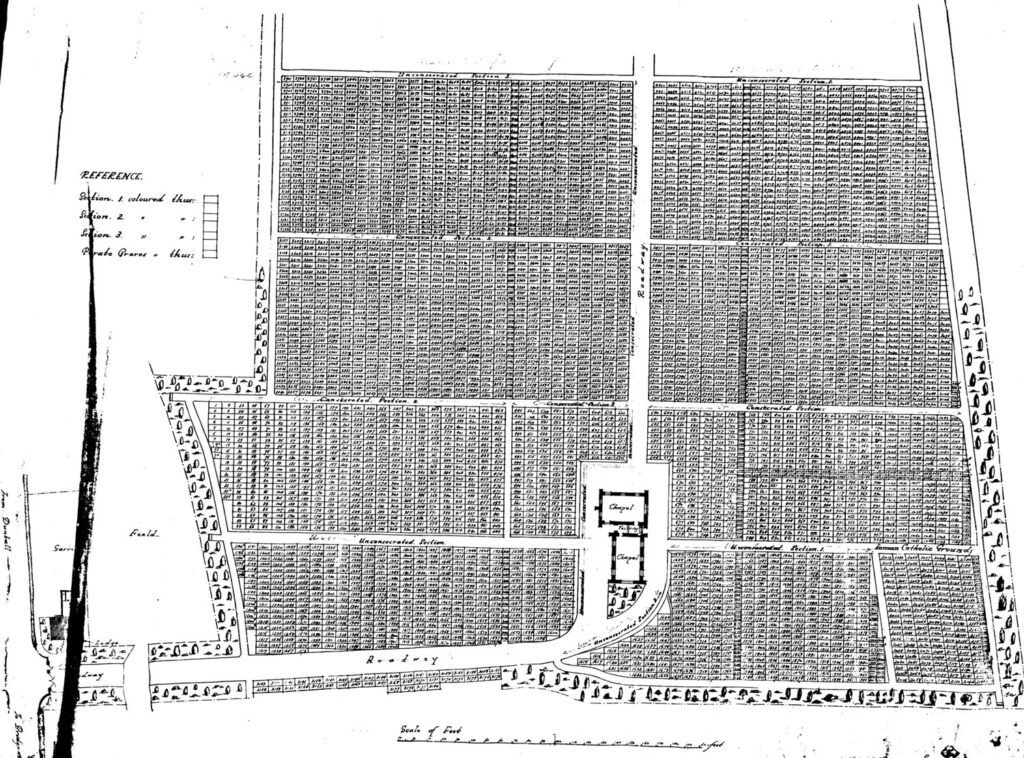
A photograph can be seen on the Somerset HER (go to maps, search for bridgwater and toggle maps) of how the cemetery appeared in 1946, taken by the RAF aerial photographs of the area . Two additional plots of ground from the 1893 extension (not on the plan above) had now been utilised on the northern side, the western being consecrated for Anglican burials.
The large earthworks in the field to the north highlight how much difficulty the initial laying out of the cemetery had taken. The curved features seem to be very unusual and the northern most part has survived the 1956 extension – should any future extension to the cemetery be made, archaeological investigation of these features would be desirable. They may be associated with tank obstacles set up during the second World War.
1956 Extension
On 16 May 1956 a petition for consecration was put forward by St John’s Joint Burial Committee for a further extension to the north of the cemetery. This was granted and the service of consecration took place on Thursday 17 May 1956, conducted by the Bishop of Taunton. In the service notes held at Wells, we learn the consecration took the form of a perambulation of the extension, while the bishop recited psalms 16 and 49. Of the large extension made to the cemetery, only the south-west portion appears to have been consecrated.[20] Combined with the 1893 extension, some ten additional acres had been added to the original site.

[1] Around twenty people attended the meeting. The low attendance was a matter of controversy in the following year, as it was felt this was too few a number to have decided on such an ambitious course. Richard Hurley voiced these objections in a letter to the secretary of state, summarising the history of the board so far. Whitehall refused to be drawn into a local dispute. It was also raised whether the people of Eastover could unilaterally appoint such a board for themselves, outwith the institutions of the town as a whole. Bridgwater Mercury, 29 November 1876, another complaint also in 22 November 1876. The board later dismissed the criticisms and it was ultimately felt that the pressing need for more burial space was more important than the legitimacy of the board. West Somerset Free Press 09 December 1876; Bridgwater Mercury, 6 December 1876; 13 December 1876
[2] Poole was asked to be clerk by Rev Collins during a chance meeting in town one day. Bridgwater Mercury 30 August 1876; 04 October 1876; 22 November 1876; 27 December 1876.
[3] At the time they were having a prolonged problem with draining the Wembdon Road Cemetery, which may have informed their objections. Western Daily Press 27 September 1875; Wells Journal 30 September 1875; Southern Times and Dorset County Herald, 2 October 1875; Taunton Courier, and Western Advertiser 06 October 1875
[4] Southern Times and Dorset County Herald 23 October 1875
[5] Bridgwater Mercury 30 August 1876. Tenders for this work had been sought back in the 17 May 1876 edition of the paper. Somerset County Gazette 17 August 1878.
[6] Bridgwater Mercury 04 October 1876
[7] Mr Durston of the board supplied the two loads of rubbish and took the two loads of turf in exchange, although a W. Pollard complained as he had wanted to buy the turf, but had been unable. It was pointed out that the turf was more valuable than the rubbish, so Durston was asked to supply more rubbish. Bridgwater Mercury 25 October 1876; 22 November 1876; 13 December 1876; 27 December 1876; Western Gazette 14 January 1876; Somerset County Gazette 17 August 1878.
[8] Bridgwater Mercury 13 December 1876; 27 December 1876
[9] Bridgwater Mercury 10 January 1877. Gibson Collection of Architectural Drawings, now deposited in the Somerset Heritage Centre: A\CMY/55
[10] Gibson Collection A\CMY/469
[11] They were still standing in 1998. Notes of Sir Mervyn Medlicott on the cemetery, published at wembdonroadcemetery.com
[12] Bridgwater Mercury 18 April 1877
[13] Southern Times and Dorset County Herald 7 April 1877
[14] Weston Mercury, 18 May 1878.
[15] West Somerset Free Press 17 August 1878
[16] Bridgwater Mercury 17 July 1878
[17] Somerset Heritage Centre, ‘Bridgwater Union Workhouse Register of Deaths, 1866-1913’, D/G/bw 69/1.
[18] Somerset County Gazette 17 August 1878
[19] Gibson Collection A\CMY/575
[20] Documents held by Harris & Harris, Solicitors, Wells.
Miles Kerr-Peterson, Prepared for Bridgwater Town Council, April 2021
